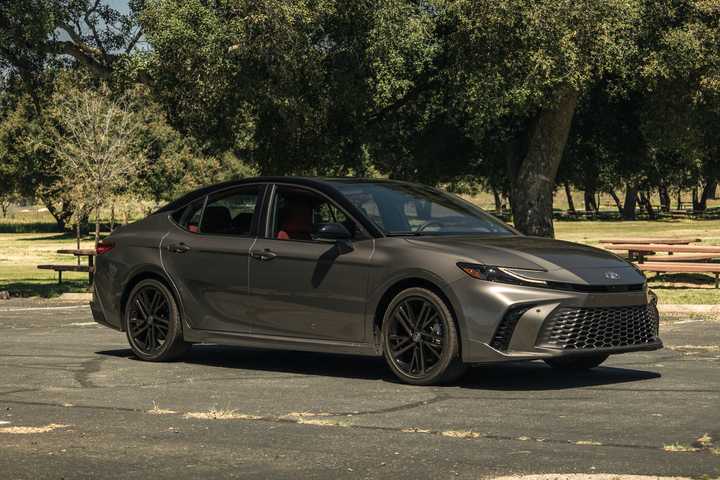Few cars have managed to achieve the same level of recognition, consistency, and trust as the Toyota Camry. For more than four decades, the Camry has stood as the benchmark in the mid-size sedan segment, winning over millions of buyers with its blend of reliability, practicality, and value. What began as a modest family sedan in the early 1980s has since become a household name across the globe, with the U.S. market serving as its biggest stage. Year after year, the Camry has proven to be one of America’s best-selling passenger cars, outselling rivals and earning a reputation as the dependable choice for families, commuters, and even fleet buyers.


- Base Trim Engine
-
2.5L Dynamic Force I4 Hybrid
- Base Trim Transmission
-
CVT
- Base Trim Drivetrain
-
Front-Wheel Drive
- Base Trim Horsepower
-
184 HP @6000 RPM
- Base Trim Torque
-
163 lb.-ft. @ 5200 RPM
- Fuel Economy
-
53/50/51 mpg (best: LE FWD)
- Base Trim Fuel Economy (city/highway/combined)
-
53/50/51 MPG
- Make
-
Toyota
- Model
-
Camry
But the Camry’s story is not just about consistency, it’s about evolution. From introducing fuel-efficient four-cylinders to offering powerful V-6 options and eventually pioneering hybrids, the Camry has adapted to changing consumer needs and industry trends. Today, with Toyota moving toward an electrified future, the Camry has fully embraced hybrid technology, reinforcing its status as both a practical and forward-looking sedan. The result is a car that has not only defined its segment but also stood the test of time as an enduring automotive icon.
To give you the most up-to-date and accurate information possible, the data used to compile this article was sourced from Toyota and other authoritative sources.
The Pioneer Of A Segment: How The Camry Became The Go-To Sedan
When Toyota first introduced the Camry in the early 1980s, it was positioned as a mid-size sedan that prioritized reliability, efficiency, and affordability. At a time when many American cars still leaned toward large, gas-hungry formats, the Camry delivered something refreshing: a vehicle that was easy to own and easy to maintain. Its combination of modest styling, excellent fuel economy, and long-term dependability quickly made it stand out in a crowded segment.
The Camry was designed not to wow with flash but to win over consumers with consistency. Owners knew they were getting a sedan that could handle daily commutes, road trips, and family duties without a fuss. This consistency was backed by Toyota’s commitment to quality control and rigorous production standards, which soon became the backbone of the Camry’s reputation.
By setting new benchmarks for reliability and practicality, the Camry pioneered what would become the “safe bet” in the sedan segment. While competitors chased trends or leaned heavily on brand identity, the Camry simply delivered on the fundamentals that mattered most to buyers, creating a template for what a family sedan should be.
Tracing The Camry’s Meteoric Rise In The U.S Market
In the 1990s and early 2000s, the Camry solidified its place as America’s favorite sedan. During this period, U.S. consumers were shifting toward vehicles that balanced comfort and practicality without breaking the bank, and the Camry fit the bill perfectly. Its roomy interior, smooth ride, and dependable four-cylinder and V-6 engines gave it broad appeal across demographics.
The Camry regularly topped sales charts, often battling the Honda Accord for the crown of best-selling passenger car. Toyota’s strategy was simple: deliver a no-nonsense sedan that could last hundreds of thousands of miles with little drama. This reliability resonated strongly with American consumers who wanted peace of mind in their daily driver.
By the mid-2000s, the Camry had become a staple of suburban driveways, corporate fleets, and rental agencies alike. Its ubiquity was a testament to how well it had struck a chord with American buyers. The Camry was no longer just a Toyota sedan—it had become synonymous with the idea of the family car.
Toyota Shows Its Ability To Evolve With The Market
As consumer preferences shifted over the decades, Toyota showed a remarkable ability to adapt the Camry without losing sight of its core values. When fuel efficiency became a bigger concern in the early 2000s, the Camry evolved with lighter platforms and more efficient engines. When technology became a differentiator, Toyota added features like touchscreen infotainment, advanced driver-assistance systems, and higher-quality interiors.
Toyota was never afraid to reimagine the Camry’s personality. Once criticized for being too bland, the brand began infusing the Camry with bolder styling and sportier trims in the late 2010s to appeal to younger buyers. The move showed Toyota understood the importance of keeping the Camry relevant in a marketplace increasingly defined by style as much as substance.
The most significant evolution came with Toyota’s embrace of electrification. Recognizing the market’s pivot toward hybrids and EVs, Toyota progressively introduced hybrid Camry models in the mid-2000s, and today, the nameplate has gone fully hybrid in some regions. This decision has positioned the Camry as not just a practical sedan, but one aligned with the future of sustainable mobility.
Why American Families Embrace The Camry’s Practicality
For many American families, the Camry is the definition of a dependable companion. Its spacious cabin offers comfort for both drivers and passengers, while its reputation for reliability ensures minimal headaches in ownership. Parents trust it as a safe and predictable car for hauling kids, while commuters appreciate its smooth ride and efficiency.
Affordability has also been a driving factor in the Camry’s family-friendly appeal. With competitive pricing and strong resale values, the Camry has always represented excellent long-term value. Families could buy one knowing that maintenance costs would remain relatively low and that the car would hold its value well when it came time to trade in.
The Camry also earned trust through consistent safety ratings. Toyota invested heavily in safety tech, equipping the Camry with features like Toyota Safety Sense as standard in recent years, which includes:
- Forward collision mitigation
- Lane keeping assist
- Adaptive cruise control
- Blind-spot warning with rear cross-traffic warning
This combination of safety, comfort, and reliability created a sedan that parents could purchase with confidence, further entrenching the Camry as the default choice for practical-minded American families.
Hybrid Hero: How Toyota’s Electrified Camry Became A Game-Changer
The introduction of the Camry Hybrid in 2007 was a turning point, signaling Toyota’s ability to integrate electrification into one of its most iconic models. The hybrid powertrain offered a dramatic improvement in fuel economy without sacrificing the sedan’s trademark reliability or comfort. For buyers, it was a chance to enjoy lower fuel bills while still driving a car that felt familiar.
Over the years, Toyota refined the hybrid system, making it smoother, more efficient, and more powerful. By the 2010s, the Camry Hybrid became a standout option for those seeking an eco-friendly yet practical family sedan. It wasn’t just a niche model; it became a central pillar of the Camry lineup, appealing to budget-conscious commuters and environmentally aware families alike.
The Camry has now reached its ninth generation, and it has evolved into, well, exactly what we all expected the car to evolve into. Like my mother’s delicious spaghetti sauce, driving it brought a tremendous amount of warmth to my soul.
– William Clavey, TopSpeed Journalist
Today, with Toyota transitioning the 2025 Camry into a hybrid-only model, the car has cemented its place as a forward-thinking yet accessible vehicle. This move reflects both Toyota’s long-term vision for electrification and the Camry’s ability to evolve without losing its essence. In doing so, it has not only maintained relevance but also reinforced its status as a pioneer.
The Secret Formula: What Keeps The Camry On Top
The Camry’s enduring success comes down to a carefully balanced formula: reliability, value, practicality, and adaptability. Toyota has never allowed the Camry to stray far from these core principles, even as it experimented with styling, hybridization, and advanced technology. This consistency has ensured customer loyalty across generations.
Unlike many competitors that have struggled to find their footing as SUVs surged in popularity, the Camry has continued to thrive. Its hybrid transition has allowed it to remain relevant in a market increasingly focused on efficiency and sustainability. Buyers know that with the Camry, they are getting a proven package that works in real life, not just on paper.
Ultimately, the Camry’s legacy is its ability to evolve while staying true to what buyers want most in a family sedan. It doesn’t need to be the flashiest or the most powerful—it just needs to be the most dependable. And in that respect, the Camry continues to deliver, making it one of the longest-standing household names in automotive history.
Sources: EPA, J.D. Power, RepairPal










